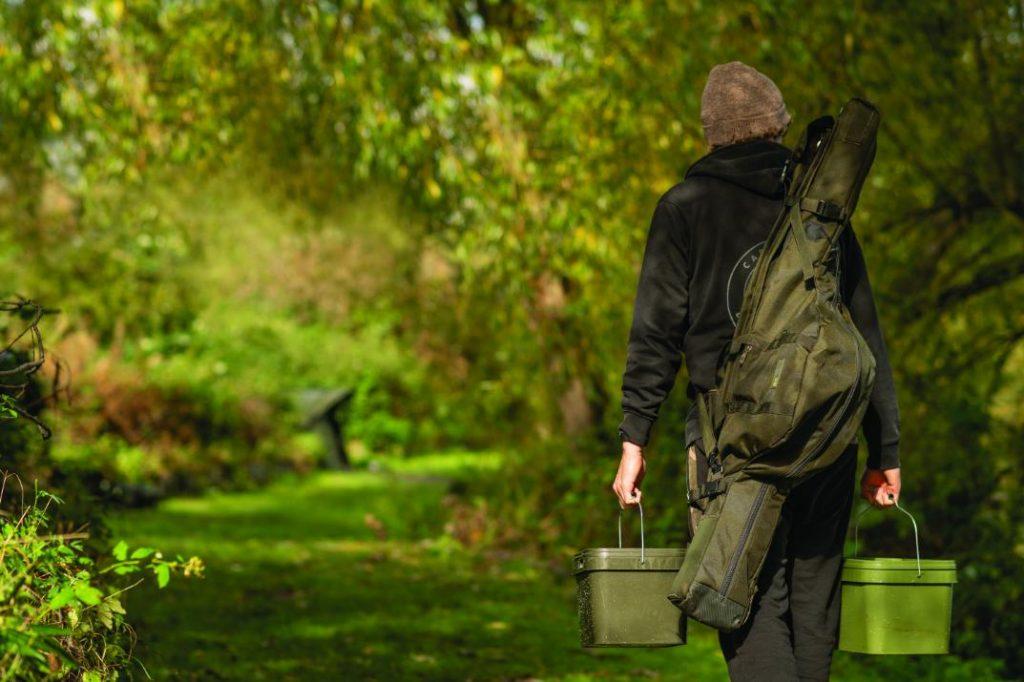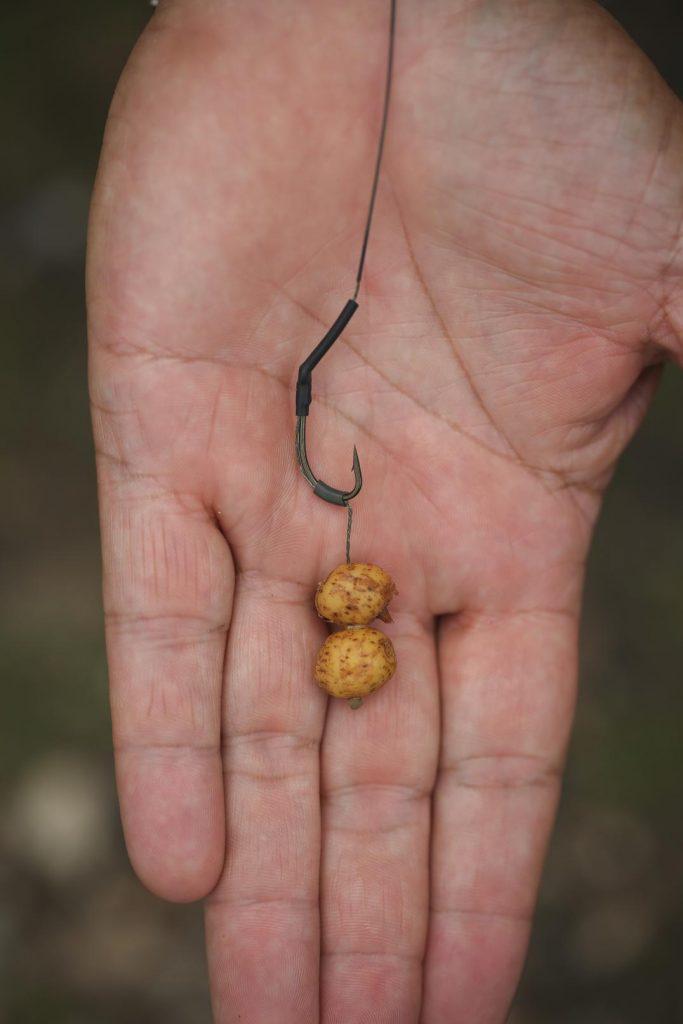Little compares to the excitement of stalking carp under the rod tip. Finding fish in the edge, watching them feed and then being in a position to observe what happens when they pick up your hookbait is likely to give any angler an adrenaline rush far greater than when sat behind a battery of rods.
There are other advantages to stalking carp, not least of which is maximising limited time on the bank. In return for rod hours, it’s probably one of the most efficient forms of carp fishing and those who have mastered it have been known to tear lakes apart. Seeing which fish you have on your spot can enable you to select a particular individual rather than fishing blind.

Stalking carp is incredibly exciting
How to Stalk Carp Under the Rod Tip
Tip 1: Stealth
One of the main things to ensure when stalking carp under the rod tip is that you don’t scare them off. Fish are more vulnerable to predation when close to the bank and, coupled with increased visibility in shallow water, are likely to be wary.
A heavy footfall will transmit vibrations into the water, sending the fish packing, so tread lightly. Try to make sure there is background cover to camouflage your outline, as sudden movements might have the same effect. It’s probably not necessary to get into full camouflage, but it won’t hurt to wear dull clothing. Another big mistake is to allow your shadow to hit the water. Carp are very aware of the danger of predation from above and will spook if a shadow hits them.
The old adage of setting up well back from the edge will do you proud. Fish won’t realise there’s a rod sticking out over the water while it remains still, but they will if you accidentally kick it. Move slowly and carefully to make your presence as unobtrusive as possible, and you won’t go far wrong.

Stalking carp is one the most exciting methods of carp fishing
Tip 2: Travel light
You don’t need a lot of kit to stalk carp from close in. In fact, the less kit you have, the easier it is to move around from spot to spot and make the most of any opportunity that may arise. A single rod and reel, a net, and mat are all the major items you need, along with a little bucket of bait and a small bag containing a few essential items of end tackle, your camera and carp care kit.
Minimal tackle means minimal effort, and it’s easier to find the motivation to go for a couple of hours if you’ve only got to throw a few of bits in the car. Similarly, when on a session, it’s easy to grab a rod and go off looking for an opportunity should your swim go quiet.
A brimmed hat or baseball cap and polarised glasses are two essential items that you don’t want to be without. If you’re going to be doing a lot of stalking, a short, 10ft rod might make it easier to fish some of the more confined nooks and crannies, and you’ll find a small reel more fun to use at close quarters.

Travel light so you can move easily
Tip 3: Bait
Small food items are the name of the game. Pellets, seed mixes, chops, and tiger nuts are all good, but corn is possibly the best all-around one. Packaged in a convenient tin, it will last in your bag or car until required. Its vivid yellow colour draws attention, and its visual quality makes it easy to see if it has been fed on. The grains are an appropriate size for both hookbaits and freebies, and carp absolutely love it.

Have a selection of baits to lightly bait a few spots
Tip 4: Baiting
The last thing you want to do when stalking carp under the rod tip is to fill it in with bait. There are usually a limited number of fish present, and you want to catch one quickly. Using too much bait cuts down the chances of one picking up your hookbait and could even spook them. It can be a tricky balance to achieve as you’re aiming to create a level of confidence but keep them hungry and competing, all in a short period of time. Keep an eye on the spot, topping it up when necessary.
One baiting strategy is to keep walking, looking for opportunities. Once you find fish close in, it’s a matter of dropping a rig, when the coast is clear, followed by a handful of freebies. Another method is to bait various spots around the lake and regularly check them for fish activity, stopping and angling when you find evidence that a spot has been visited.

Don’t over bait, scatter less than a handful of bait and sit, wait and watch
Tip 5: Spots
There are lots of spots that are suitable for stalking in the edge. Clean gravel, firm silt, sand and clay are all good. Preferably they’ll be ones where you can see the rig and how it has landed, enabling you to reposition it if it isn’t sitting right. Light levels are usually good, meaning you’ll get away with a lot less in the edge so good presentation is paramount. Try to avoid weedy and choddy spots, as watching carp feed on top of your rig without a pick-up will make you want to keep moving it, and it’s extremely disappointing to reel in afterwards and find the hook point caught up in weed or impaled in a stick.
Tip 6: Rigs
Clear spots that are tightly baited call for a bottom bait or balanced offering, and there is little call for pop-up rigs. Stalking rigs need to be kept simple as you don’t want to be carrying a vast array of end tackle and all those bells and whistles aren’t really appropriate for the delicate presentation that is required. You won’t have access to a kettle for shrink tube so we’d recommend a hook pattern that turns on its own, without any additions. A short, curved shank pattern is ideal and a downturned eye helps too. A grain or two of corn, a single tiger or trimmed down wafter necessitates a fairly small hook and something like a size 8 is likely to fit the bill. Make sure it is a strong pattern, though, as margin-hooked carp can charge off at speed and you can be sure there will be snags and obstacles nearby.
When lowering rigs, the anti-tangle qualities of coated braids are redundant. Around six-inches of soft, uncoated braid, which can be relied upon to sit well, is a better option. The mechanics of the rig still need to be effective, as it can be incredibly frustrating to watch carp feeding and repeatedly getting away with it. We’d go for something like a blowback rig, a slip D or just a basic hair rig, but anything that is simple, quick and easy to tie and that you are confident in will be just fine.
A heavy leader that pins everything down is an advantage. Lead-free material is more flexible than leadcore and will hug the contours of the bottom. As you aren’t casting, you can take advantage of the superior hooking qualities of inline leads. In this regard, many like to go really big and opt for a 5oz flat pear, although a 2oz lead usually does the job well enough and can be lowered down more delicately. We’d favour fishing these drop-off style, particularly if going big.

Keep rigs simple
Tip 7: Placement
Watching fish visit and feed can tell you precisely where you want to place your rig, as they sometimes show a propensity for a very tight part of the spot. Ideally, you want your rig on the nearside so that you don’t have a line running across the baited patch.
Tip 8: Safety
Inevitably, some of the carp you find will be taking advantage of cover in the form of snags. Do make sure you can land them from where you fish for them and have a plan for when you hook one. Alternatively, it’s a good ploy to bait a spot nearby as they will sometimes leave the security of cover to search out food when bite time comes around.
That’s our quick guide to stalking carp in the edge. Try not to over complicate life and concentrate on the things that matter, like finding the carp, getting them feeding and watching what they are doing… all while being convinced that your heart is beating loud enough for them to hear it!